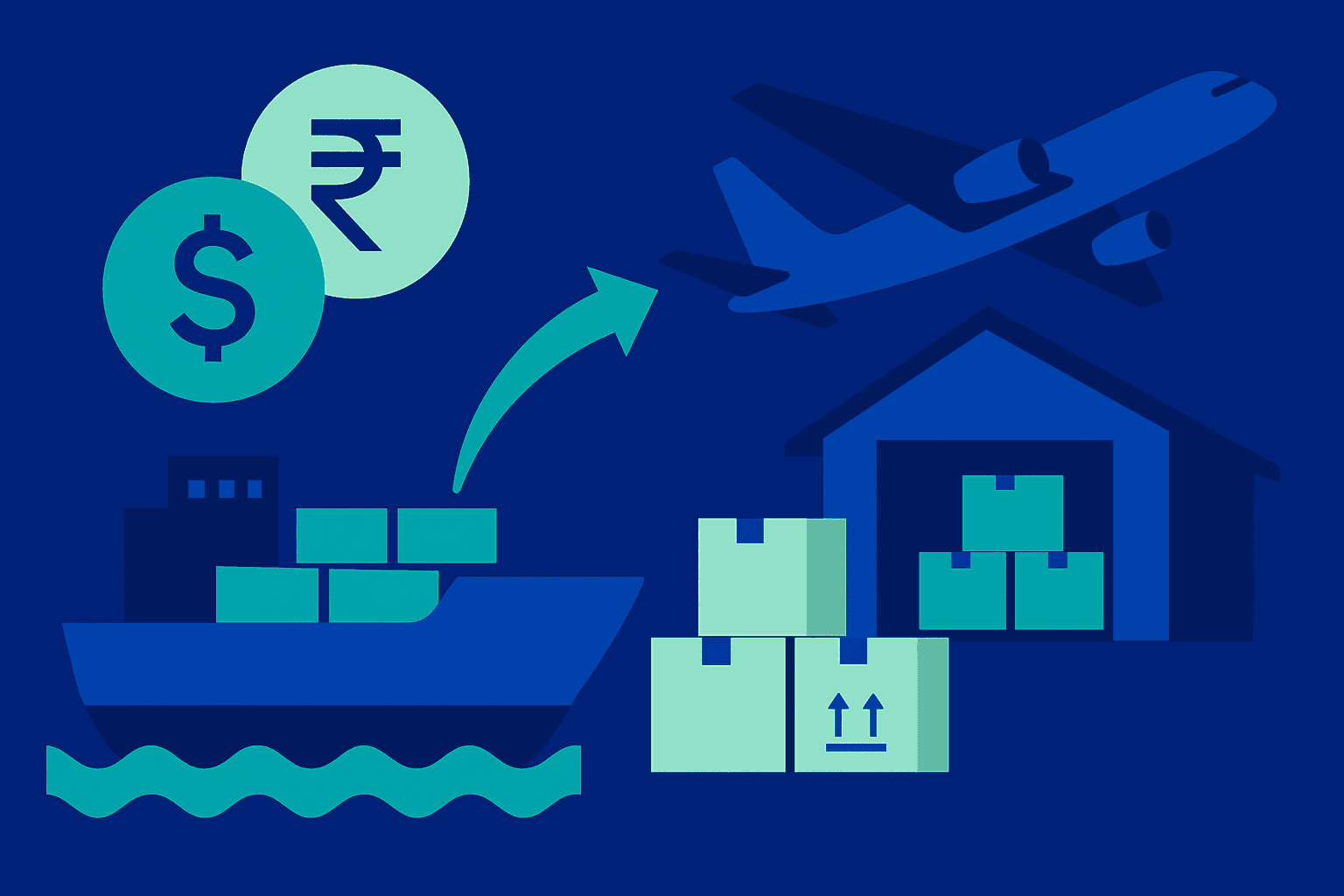How Long Does an International Wire Transfer Take? (+ Faster Alternative for Indian Exporters)

When your client says, “I’ll wire you the money,” they’re talking about an international wire transfer. Simply put, it’s a bank-to-bank payment sent across borders. These transfers run on the SWIFT network – a secure system that connects more than 11,000 banks around the world. Think of it as a global messaging system where banks talk to each other to move your money safely.
Here’s how it works: your overseas client enters your account number and your bank’s SWIFT/BIC code, hits send, and the money makes its way through SWIFT until it lands in your Indian bank account. Big companies and platforms like Amazon Global or Upwork still prefer wires because they’re reliable, can handle large payments, and support all major currencies.
Why Wire Transfers Are So Common
- Global Reach and Trust: Wire transfers use the SWIFT network connecting thousands of banks across 200+ countries. With over 50 years of legacy, this system is well-understood and trusted by banks. Nearly any bank in the world can send or receive a wire.
- Preferred by Big Businesses: Many international marketplaces (Fiverr, Upwork, Amazon Global, etc.) let clients pay vendors via wire. Businesses like this favour wires because they only need the recipient’s bank details, and every transfer comes with a traceable reference (the SWIFT MT103) for tracking and proof of payment.
- High-Value Payments: Wires can handle very large sums securely. The encrypted SWIFT network and stringent banking security frameworks (like RBI/Swift CSCF guidelines) protect transfers from fraud or interception.
- Wide Bank Support: Almost all Indian banks (HDFC, ICICI, SBI, Axis, Kotak, etc.) support incoming international wires. You don’t need a special account or service – your ordinary business or current account works, making it easy to receive money from abroad.
Despite these advantages, wire transfers have downsides: they are relatively slow, often incur hidden fees or poor exchange rates, and offer little visibility on the funds during transit. We explore the timing and drawbacks below.
How Long Do International Wire Transfers Take?
Typically, international wire transfers take 1–5 business days to complete. In the best case, if everything aligns (banks have a direct relationship, the sender initiates early in the day, no currency conversion needed), money can arrive in 1–2 days.
A more common scenario is 3–4 days for the funds to clear. Occasionally, complications can stretch it to 5 or more business days. Factors like bank cut-off times, weekends/holidays, and compliance checks can add days (for example, a Thursday wire that meets a holiday on Friday may not complete until Monday).
Average International Wire Transfer Time by Region
| Origin Country/Region | Average Time to India | Notes |
| UAE → India | 1–2 business days | Simple corridor, usually no intermediary banks |
| UK → India | 1–2 business days | Fast, often direct relationships between banks. |
| Europe (EU) → India | 2–4 business days | Time zone differences + possible intermediary banks add time. |
| USA → India | 3–5 business days | Longer route, more compliance checks and intermediary hops. |
| Australia → India | 2–3 business days | Moderate timing; faster than US but slower than UK/UAE. |
These are ballpark timelines. Actual transfer time can vary due to factors like intermediary banks, compliance checks, incorrect details, weekends, or public holidays (in either country).
Reasons Why Your Wire Transfer Might Be Delayed
International payments can be held up for many reasons beyond your control:
- Intermediary Banks: If the sender’s and receiver’s banks don’t have a direct relationship, the wire must pass through one or more intermediary banks. Each hop can add 1–2 business days and a $10–$30 fee, further delaying your payout.
- Currency Conversion Windows: Indian banks convert incoming foreign funds to INR during market hours (typically 9am–5pm IST). If your payment arrives after this window, the conversion may wait until the next business day. For example, a late-evening USD remittance might sit unconverted until morning. (Banks are expanding round-the-clock FX, but some delays can still occur outside normal forex hours
- Compliance & Purpose Codes: RBI regulations require every inward remittance to carry a valid purpose code. If this code is missing or wrong (e.g. using the wrong code for software services), the bank holds the money for manual review. They may then request invoices or contracts. According to RBI guidelines (and Skydo’s compliance guide), using the wrong purpose code can lead to processing delays and even penalties. Always ensure your client uses the correct code (for instance, P0802 for software consulting services to India)
- Incorrect Bank Details: Even a single typo in the SWIFT/BIC code or account number can cause the transfer to bounce or route incorrectly. In that case, the funds might be returned to the sender (after delays) or end up in the wrong branch, requiring reissue. Stripe notes that incorrect account info almost always forces a manual fix, further delaying the transfer.
- Recipient Bank Processing: After arrival in India, each bank has its own internal processing schedule. Your bank may hold incoming wires in a queue, verify the payment, convert currency, and then credit your account. This often happens in batch processes. So, if your money reaches Bank X in the morning, it might only be credited by evening or the next day after all checks are done.
- Weekends and Holidays: Banks only process wires on business days. If either the sender’s or receiver’s country has a bank holiday (or it’s a weekend), the transfer pauses. For example, a US-originating wire sent on Thursday may not clear on Friday if the US bank is closed, pushing completion to Monday or later. Likewise, an incoming payment arriving just before Diwali in India might sit idle until banks reopen.
Pros and Cons of Wire Transfers (Especially for Indian Exporters)
| Pros | Cons |
| Globally accepted – almost any client or business worldwide can send you money via wire, | Slow – typically takes 1–5 business days to credit, sometimes longer. Not ideal if you need urgent funds |
| Strong security: transfers go through regulated banking networks with encryption, fraud checks, and KYC/AML measures | Hidden fees: intermediary banks deduct SWIFT fees or flat charges, often undisclosed upfront, reducing your final payout |
| Supports large payments: well-suited for export deals and enterprise invoices | Poor FX rates: banks add 1–3% markup on exchange rates, reducing value. Example: if mid-market USD/INR is ₹84, a 2% markup means you only get ₹82 – a ₹2 loss per dollar |
| Easy For Payers: Clients only need your account details to initiate | No automatic FIRA – Most banks don’t issue the Foreign Inward Remittance Certificate by default. You must request it, pay a fee, and follow up manually. |
How to Receive International Payments Faster (Without the Stress)
While you can’t control foreign bank policies, you can take steps to minimise delays on your end:
- Double-check all transfer details: Make sure your client has your exact account number, IFSC code, and SWIFT/BIC. One wrong character can derail a transfer. Confirm and reconfirm these details.
- Use a Current/Business account: Avoid using a personal savings account for big inflows. Savings accounts often have withdrawal limits and stricter scrutiny on large credits, which can trigger holds. A dedicated current/business account handles international remittances more seamlessly and has higher transaction thresholds.
- Tell your client to send remittance advice: The SWIFT MT103 confirmation (often called “remittance advice”) contains the transaction reference number and routing details. Ask your client to email you this as soon as they send the wire. If there’s a holdup, this reference helps you and your bank trace the payment quickly.
- Watch for cut-off times: Advise overseas payers to initiate transfers early in their local banking day. If a wire is sent very late in the day (or on a Friday or holiday), it will only be processed on the next working day. Early initiation reduces idle time.
- Avoid low-transparency banks: Some traditional banks provide little detail on in-flight wires. Digital-first platforms and fintechs often give real-time status updates and clear fee breakdowns, so you’re not left in the dark about deductions or hold-ups. Consider letting clients use well-known global transfer services or platforms that guarantee mid-market FX rates.
- Provide all compliance info up front: Give your client the correct RBI purpose code for the transaction (e.g. P0802 for software services. If they include it, you eliminate one cause of compliance checks. Attach any required invoices or contracts with the payment instruction so your bank has documents ready.
Comparison of Payment Methods
| Method | Typical Speed | Fees and Fx | Tracking & Visibility |
| Bank wire transfer | 3–5 business days on average | High fees (bank wire fees + 1–3% FX markup) | Some level of tracking though SWIFT and third party platforms |
| Wise (TransferWise) | 1-2 business days | 1.6-1.8% fee with mid market rates | Good; you can track the payment online through Wise’s dashboard. |
| PayPal | 2–5 business days | High fees (varies by currency), FX markup | Limited; notify on transfer, but less formal than banks. |
| Western Union | 1-5 business days | Fixed fee+ fx markup | Strong; each transfer has an MTCN tracking number. |
| Skydo | 24–48 hours | Flat transparent fee + true mid-market FX (0% margin) | Excellent; real-time status updates |
Skydo: Faster, Simpler Global Payments for Indian Exporters
One modern solution is Skydo – a fintech built for Indian exporters and freelancers. Skydo issues you virtual bank accounts in countries like the USA, UK, Australia, and more. When a client in, say, the US sends USD to your virtual USD account, Skydo instantly receives it as a domestic wire. They convert and credit INR to your Indian account within about 24–48 hours, instead of waiting days for a traditional SWIFT transfer.
Skydo’s platform is transparent: they charge a flat fee per transfer and give you the exact mid-market exchange rate (zero hidden forex markup)Unlike banks, Skydo automatically generates the required FIRA for your receipt with no extra work You also get real-time tracking of your transfer status, so you always know where the money is. Dozens of businesses have switched to Skydo to avoid the usual wire transfer uncertainty.
If you’re tired of wondering when (or if) your SWIFT payment will show up, consider a modern payments platform. With Skydo and similar services, “what you see is what you get” – all fees upfront, mid-market rates, and fast settlements
How long does an international wire transfer usually take?
In general, expect 1 to 5 business days for the funds to land in your account. Quick transfers (1–2 days) happen when banks are in sync; most take 3–4 days. Occasionally, issues like holidays or compliance checks can push it beyond 5 days.
Can I make the transfer arrive faster?
Why was my wire delayed after reaching India?
What is a SWIFT/BIC code and why do I need it?
What is a FIRA and why is it needed?












